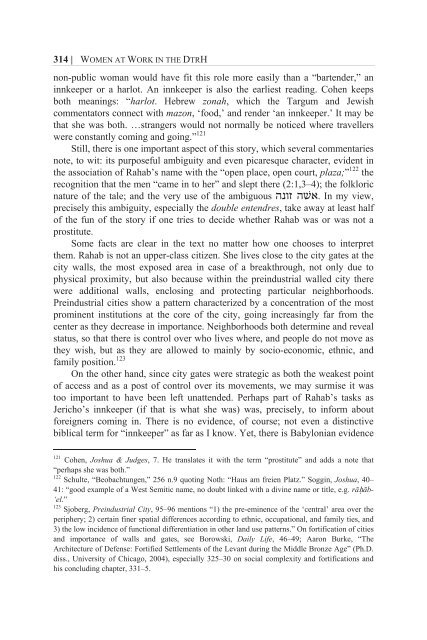Women at Work in the Deuteronomistic History - International Voices ...
Women at Work in the Deuteronomistic History - International Voices ...
Women at Work in the Deuteronomistic History - International Voices ...
Create successful ePaper yourself
Turn your PDF publications into a flip-book with our unique Google optimized e-Paper software.
314 | WOMEN AT WORK IN THE DTRH<br />
non-public woman would have fit this role more easily than a “bartender,” an<br />
<strong>in</strong>nkeeper or a harlot. An <strong>in</strong>nkeeper is also <strong>the</strong> earliest read<strong>in</strong>g. Cohen keeps<br />
both mean<strong>in</strong>gs: “harlot. Hebrew zonah, which <strong>the</strong> Targum and Jewish<br />
comment<strong>at</strong>ors connect with mazon, ‘food,’ and render ‘an <strong>in</strong>nkeeper.’ It may be<br />
th<strong>at</strong> she was both. …strangers would not normally be noticed where travellers<br />
were constantly com<strong>in</strong>g and go<strong>in</strong>g.” 121<br />
Still, <strong>the</strong>re is one important aspect of this story, which several commentaries<br />
note, to wit: its purposeful ambiguity and even picaresque character, evident <strong>in</strong><br />
<strong>the</strong> associ<strong>at</strong>ion of Rahab’s name with <strong>the</strong> “open place, open court, plaza;” 122 <strong>the</strong><br />
recognition th<strong>at</strong> <strong>the</strong> men “came <strong>in</strong> to her” and slept <strong>the</strong>re (2:1,3–4); <strong>the</strong> folkloric<br />
n<strong>at</strong>ure of <strong>the</strong> tale; and <strong>the</strong> very use of <strong>the</strong> ambiguous הנוז השׁא. In my view,<br />
precisely this ambiguity, especially <strong>the</strong> double entendres, take away <strong>at</strong> least half<br />
of <strong>the</strong> fun of <strong>the</strong> story if one tries to decide whe<strong>the</strong>r Rahab was or was not a<br />
prostitute.<br />
Some facts are clear <strong>in</strong> <strong>the</strong> text no m<strong>at</strong>ter how one chooses to <strong>in</strong>terpret<br />
<strong>the</strong>m. Rahab is not an upper-class citizen. She lives close to <strong>the</strong> city g<strong>at</strong>es <strong>at</strong> <strong>the</strong><br />
city walls, <strong>the</strong> most exposed area <strong>in</strong> case of a breakthrough, not only due to<br />
physical proximity, but also because with<strong>in</strong> <strong>the</strong> pre<strong>in</strong>dustrial walled city <strong>the</strong>re<br />
were additional walls, enclos<strong>in</strong>g and protect<strong>in</strong>g particular neighborhoods.<br />
Pre<strong>in</strong>dustrial cities show a p<strong>at</strong>tern characterized by a concentr<strong>at</strong>ion of <strong>the</strong> most<br />
prom<strong>in</strong>ent <strong>in</strong>stitutions <strong>at</strong> <strong>the</strong> core of <strong>the</strong> city, go<strong>in</strong>g <strong>in</strong>creas<strong>in</strong>gly far from <strong>the</strong><br />
center as <strong>the</strong>y decrease <strong>in</strong> importance. Neighborhoods both determ<strong>in</strong>e and reveal<br />
st<strong>at</strong>us, so th<strong>at</strong> <strong>the</strong>re is control over who lives where, and people do not move as<br />
<strong>the</strong>y wish, but as <strong>the</strong>y are allowed to ma<strong>in</strong>ly by socio-economic, ethnic, and<br />
family position. 123<br />
On <strong>the</strong> o<strong>the</strong>r hand, s<strong>in</strong>ce city g<strong>at</strong>es were str<strong>at</strong>egic as both <strong>the</strong> weakest po<strong>in</strong>t<br />
of access and as a post of control over its movements, we may surmise it was<br />
too important to have been left un<strong>at</strong>tended. Perhaps part of Rahab’s tasks as<br />
Jericho’s <strong>in</strong>nkeeper (if th<strong>at</strong> is wh<strong>at</strong> she was) was, precisely, to <strong>in</strong>form about<br />
foreigners com<strong>in</strong>g <strong>in</strong>. There is no evidence, of course; not even a dist<strong>in</strong>ctive<br />
biblical term for “<strong>in</strong>nkeeper” as far as I know. Yet, <strong>the</strong>re is Babylonian evidence<br />
121<br />
Cohen, Joshua & Judges, 7. He transl<strong>at</strong>es it with <strong>the</strong> term “prostitute” and adds a note th<strong>at</strong><br />
“perhaps she was both.”<br />
122<br />
Schulte, “Beobachtungen,” 256 n.9 quot<strong>in</strong>g Noth: “Haus am freien Pl<strong>at</strong>z.” Sogg<strong>in</strong>, Joshua, 40–<br />
41: “good example of a West Semitic name, no doubt l<strong>in</strong>ked with a div<strong>in</strong>e name or title, e.g. rāHāb-<br />
‘el.”<br />
123<br />
Sjoberg, Pre<strong>in</strong>dustrial City, 95–96 mentions “1) <strong>the</strong> pre-em<strong>in</strong>ence of <strong>the</strong> ‘central’ area over <strong>the</strong><br />
periphery; 2) certa<strong>in</strong> f<strong>in</strong>er sp<strong>at</strong>ial differences accord<strong>in</strong>g to ethnic, occup<strong>at</strong>ional, and family ties, and<br />
3) <strong>the</strong> low <strong>in</strong>cidence of functional differenti<strong>at</strong>ion <strong>in</strong> o<strong>the</strong>r land use p<strong>at</strong>terns.” On fortific<strong>at</strong>ion of cities<br />
and importance of walls and g<strong>at</strong>es, see Borowski, Daily Life, 46–49; Aaron Burke, “The<br />
Architecture of Defense: Fortified Settlements of <strong>the</strong> Levant dur<strong>in</strong>g <strong>the</strong> Middle Bronze Age” (Ph.D.<br />
diss., University of Chicago, 2004), especially 325–30 on social complexity and fortific<strong>at</strong>ions and<br />
his conclud<strong>in</strong>g chapter, 331–5.




